Rennie Scaysbrook | October 21, 2016
Challenges are a given in racing, and this team is taking on a bigger one than most with the only Ducati Panigale R to race in MotoAmerica
 The #RideHVMC Ducati Panigale R Superstock racer has the lone V-twin voice in a sea of four-cylinder engines.
The #RideHVMC Ducati Panigale R Superstock racer has the lone V-twin voice in a sea of four-cylinder engines.
“We’re not looking for a window with this bike. We’re looking for a house to build a window.” That comment from New York’s Corey Alexander gives you an idea of the challenge he and Team Freeman Racing #RideHVMC Ducati are up against when trying to develop the only Ducati Panigale R in MotoAmerica Superstock 1000 into a race-winning package.
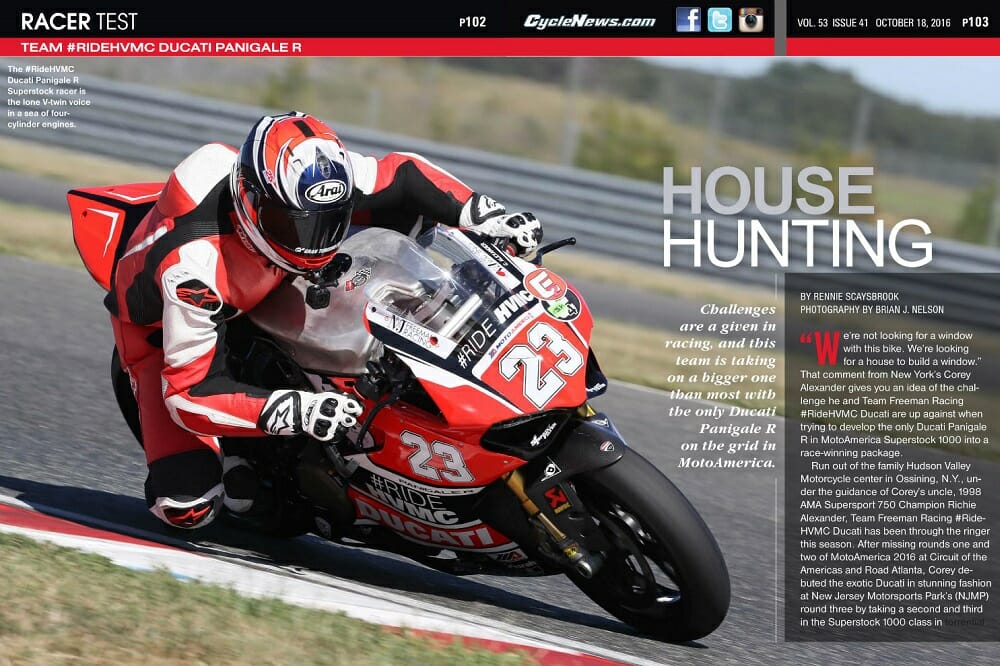
To read this in Cycle News Digital Edition, click HERE
Photography by Brian J. Nelson
Run out of the family Hudson Valley Motorcycle center in Ossining, N.Y., under the guidance of Corey’s uncle, 1998 AMA Supersport 750 Champion Richie Alexander, Team Freeman Racing #RideHVMC Ducati has been through the ringer this season. After missing rounds one and two of MotoAmerica 2016 at Circuit of the Americas and Road Atlanta, Corey debuted the exotic Ducati in stunning fashion at New Jersey Motorsports Park’s (NJMP) round three by taking a second and third in the Superstock 1000 class in torrential conditions. That was as good as it got for the team in 2016, with very little testing done and an electronics package that required a Ducati Corse technician to be flown from Italy prior to round eight at Laguna Seca to begin cracking the Ducati ECU’s many codes and getting the machine to start behaving itself. Not only that, this is Corey’s rookie year on the big bike in competition after a career so far spent on 600cc machinery. Understanding the Ducati has at times been like trying to speak Italian.
“My practice bike was a Suzuki GSX-R1000,” Corey says, “and the difference between a GSX-R1000 and a GSX-R600 is it’s basically the same bike with a little more power and a bit heavier. The Ducati is totally different. It’s a V-twin, for starters, there’s no frame to speak of, it’s got a single-side swingarm, the feel and feedback is very different to what I’ve ridden before, and the engine’s got a lot more power with a vast array of electronics. You have to ride it differently.”
Choice words, indeed.
And with that, I’m directed over to the waiting red and white beast for the first of my two six-lap sessions at New Jersey Motorsports Park, the day after the dramatic MotoAmerica final.
The cockpit all looks relatively familiar—the race bike runs the same dash as the production bike, yet the clip-on bar switches are totally different. On the right side is the red ignition, blue lap timer and black start buttons, and the left side houses a white button used at standstill to select either traction control, wheelie control or engine braking control (this cannot be used while in motion), two black buttons above and below the mode button to scroll through the different modes and two green buttons to then delve into the different settings of the chosen map. It sounds more complicated than it really is.
The Panigale R still runs the standard ignition key, although it’s located at the left front of the cockpit behind the fairing. Running the key is something required by the stock ECU; however, when the team changes to the Magneti Marelli system next season in Superbike as part of new class rules, this will not be required.
Corey’s bike is noticeably taller than any of the Japanese competition although the ride position doesn’t throw a massive amount of weight on your wrists. It’s skinny and svelte, with bars set slightly inward and thin red and white race grips that transmit every rattle and tingle to the rider’s hands.
 (Left) Akrapovic full titanium race exhaust comes straight from the Ducati Corse parts bin. (Right) Standard calipers are squeezed by a larger Brembo master-cylinder. K-Tech internals sit in the Öhlins fork.
(Left) Akrapovic full titanium race exhaust comes straight from the Ducati Corse parts bin. (Right) Standard calipers are squeezed by a larger Brembo master-cylinder. K-Tech internals sit in the Öhlins fork.
Despite the Akrapovic titanium race exhaust that sits in front and below the engine, Alexander’s machine is not overly loud on start up. It’s certainly nothing like a WorldSBK-spec Ducati, which sounds more like a bombing raid than a motorcycle—it’s a fair more sedate experience, although it does have a certain meanness to the exhaust note. It’s a stock-standard engine bolted to the monocoque chassis, not even kit camshafts are used by #RideHVMC, so this bike could (nearly) still pass the DMV’s noise meter if asked.
The idle noise is about where the civility of Corey Alexander’s Ducati Panigale R ends. A production bike it may be, the #RideHVMC racer is still brutally fast thanks to a motor that pumps out 93 lb-ft of torque at 8500 rpm and 188 horsepower at 12,000 rpm on the team’s dyno. Surprisingly for a V-twin, there’s not much go in the lower revs.
 The side-to-side turn speed of the Panigale R is seriously quick.
The side-to-side turn speed of the Panigale R is seriously quick.
It is essential to have the Panigale R’s two pistons blasting up and down the 112 x 60.8mm bore above 7000 rpm to have meaningful drive off the NJMP corners, especially the fourth gear right-hand sweeper entering the start and finish straight. Let the revs drop below 6000 rpm off corners three and seven and drive suffers—first gear is short enough that it’s not used (at least at NJMP), while second gear only starts giving solid grunt at about 6500 rpm. The Panigale R is thus the most four cylinder-ish engine yet seen from Bologna, requiring high revs to produce the high horsepower needed in MotoAmerica competition.
Once you’re above 8000 rpm, however, hold on. The Panigale R builds speed like a bullet train accompanied by one of the best induction sounds known to man as you snatch fifth gear briefly via the race-pattern, Ducati Quick Shift (up and downshift)-equipped gearbox. The front straight seems very short when you’ve got 188 horsepower in your right hand.
 Alexander had to put up with electrical issues all season, which hampered development.
Alexander had to put up with electrical issues all season, which hampered development.
Keep the motor in the 4000 rpm-odd power range and it’ll punch along with the best four-cylinder bikes in the Superstock class. It takes a brave rider to snap the throttle on at 10,000 rpm on the Panigale R when cranked over because it fair launches at the horizon at this speed. Conversely, the higher revs put more stress through the monocoque chassis and it can become a handful when trying to slow for corners, tipping with incredible pace from upright to full lean that it catches me off guard a couple of times. The bike is so light the team has to add weight in the center of the bellypan to get the bike up to the minimum weight of 374 pounds.
The #RideHVMC team uses K-Tech suspension in similar spec to what Shane Byrne and the Paul Bird Motorsport team run in the British Superbike Championship, as opposed to the Öhlins the bike was designed with. At my pace the K-Tech set up feels superb, a little on the stiff side in the rear but every nook and cranny of the NJMP layout feels transmitted to my hands and bum, so feedback is certainly not an issue. That ultra-quick turn in is a personality trait from the Panigale family, allowing it to dive for apexes with amazing turn speed, if swapped for a touch less stability than the Japanese competition. The lean angles Corey Alexander pulls on this beast are certainly impressive.
The Ducati will stop on a dime thanks to the standard Brembo M50 calipers from the production Panigale R squeezed by a new Brembo 19 x 20 master-cylinder fitted by the team. The brakes offer outstanding stopping power, matched to the standard ECU’s three-way Engine Braking Control (EBC) map that’s taken almost half the season to get to Corey’s liking. The EBC’s job is to speed up the rear wheel to match the front by opening the throttle bodies just enough so you don’t back the bike into turns, but, as Corey says, “When entering the turns, the adjustments the system was making was adding fuel to that little throttle input. There would be fuel sitting on top of the throttle body. You’re only supposed to have three percent throttle (on the EBC map) and it’s giving you 3.9 percent throttle. That 0.9 percent is the reason why I couldn’t slow down and turn in.
 (Left) The standard dash is accompanied by all the usual buttons you’d expect from a top line racer on the bars. Interestingly, there’s no pit lane speed limiter and no launch control on this bike. (Right) AIM data logger sits under the tail section.
(Left) The standard dash is accompanied by all the usual buttons you’d expect from a top line racer on the bars. Interestingly, there’s no pit lane speed limiter and no launch control on this bike. (Right) AIM data logger sits under the tail section.
“It’s not like you’re running off the back straightaway with the throttle full-on; it’s when you’re trail braking and you’re like, ‘the bike’s not turning—why?’ Then you start going after chassis stuff and you realize, shit, it’s not the chassis, it’s the fact that the fuel mapping is off.”
This translated to more issues when the throttle was opened for corner exit. Corey again: “From there the bike would go lean, because it burned off all that fuel that was sitting there—it would just go dead. Then it goes super rich and you have this big power hit at the apex rolling on the throttle. So you’re riding a bike that amongst all that is spinning and backing in and doing all the stuff that a normal bike does and you’re trying to ride around that.”
For my ride, however (and, it must be said, at a rather slower speed than Corey’s), the Panigale R’s throttle response seems sorted. The initial touch of the gas from closed is nicely metered—still with a hint of aggression but nothing like what Corey explained to me earlier. This allows for a much smoother corner exit without the chassis tying itself in knots and, importantly, not over-stressing the rear Dunlop that’s part of the control-tire package for MotoAmerica.
Much of this has to do with the deft touch of the Ducati Corse traction-control map out of the standard ECU. It’s a soft action cut of forward motion, nothing at all like early Panigale systems that would slam your family jewels into the tank when in action. Across the two six-lap sessions, I engage the TC system only a couple of times, purely down to me not being comfortable enough on a brand-new track to really push this foreign machine that I don’t own and, more importantly, can’t afford if I crash!
Despite this, hitting throttle hard out when cranked right over out of turn four is a blast on this bike. Power progressively dialed in through second gear, the first red shift lights making their appearance at 11,000 rpm, front wheel pawing the air at roughly 100 mph, then slamming the number 23 on the knee for the deceptively fast right-hand turn five and the left for turn six—it’s why I love big-bore, big-tech race bikes. The Panigale just flows through here, dancing from one corner to the other, although if I were going any quicker I’m sure the dance would start to become more of a fight and the tolerances for error ever smaller.
And that is what Corey Alexander’s been facing this year. The margin for error is tiny at best in MotoAmerica, and the Panigale R is a double-edged sword. Get the set-up right, and the Ducati is a weapon par-excellence. Get it wrong and you’ll go nowhere, fast. In that case, Corey Alexander’s Ducati Panigale R Superstock racer is no different to the Desmosedici GP16 ridden by Andrea Dovizioso in MotoGP or the Panigale R ridden by Chaz Davies in WorldSBK.
 Isn’t she pretty?! The presentation of the #RideHVMC machine has been beyond reproach this season.
Isn’t she pretty?! The presentation of the #RideHVMC machine has been beyond reproach this season.
The #RideHVMC team has done an excellent job turning this production machine into a racer but there’s a way to go, yet. The team is still debating what class to run next year in MotoAmerica—continue with the superstock development or step up to the superbike plate, which will see full house WorldSBK rules in place. A move to superbike might be more of a help to the team as they’ll be using the same electronic system as the factory WorldSBK Aruba.It Ducati team currently running Chaz Davies and Davide Giugliano, rather than the standard ECU equipment they currently utilize.
Regardless, in superstock form, Corey Alexander’s bike is a beautiful beast. It’s by far the most expensive superstock machine on the grid and a true point of difference to the hordes of blue and white Yamahas populating the pack. The electronic breakthroughs the team made may have come too late for this season, but they’ve got a talented young rider and could spring a few surprises next season.

Corey Alexander
Twenty-two-year-old Corey Alexander’s been a professional racer from the day he turned 16. A former Red Bull Rookies, AMA Superstock and Supersport racer, this year has seen Corey jump straight into the big time with his uncle’s team on a totally different bike to the competition.
How has the jump to the 1200 Ducati been this year?
I’ve been riding 1000s a bit, but this bike is different. I basically raced GSX-R600s my whole career, until last year. As far as the issues we’re facing, I think they are symptoms of that a bit. The hard part as a rider, especially a young rider, not really knowing how to decipher what is what. If you look everywhere else in the world, the Ducati is pretty competitive, so there’s no reason it shouldn’t be here but first you’ve got to figure out how to make it competitive.
You’re on K-Tech suspension as well?
Yeah, pretty much what Shane Byrne’s team runs in BSB (British Superbike Championship). I’ve been on K-Tech for a long time now and I don’t see it being much different to Öhlins. Last year I rode Öhlins on the Tuned Racing R6 and I preferred the K-Tech over it. Now we know the equivalent settings from Öhlins to K-Tech, and we’re getting notes sent from European Superstock on the right setting for this bike.
One of the things we were trying to accomplish was putting more weight on the front to get it to help turn. So right now it’s soft in the rear with a lot of preload and a little bit stiffer in the front. We started out the final MotoAmerica weekend trying everything. I think we started on 1.0 springs on the front and no preload, a lot of preload, high, low—we’re not looking for a window. We’re looking for a house to build a window. It’s been interesting for me because I’m learning but at the same time it’s tough because it’s all on me.
What were some of the issues with the electronics over the year?
We had the Tune Boy software at the start of the year and we’d try to clean up the fuel maps on the stock ECU, but the problem was that we were only editing the top layer. The stock ECU, it’s crazy how good it is. There’re so many layers to it. We were editing basically the top layer of the fueling and we needed to be able to get in and go to every layer, but we didn’t know that. We would go in, look at the data and say, “Okay, it’s running really rich here.” So we’d go into the Tune Boy software and add a 10 percent change, and I’d go back out and ride and it was no different. Eventually we figured out we were only editing the top layer of the map, so all year we were throwing these 10 percent, eventually 30 percent changes, and it was actually making it worse because the bike was compensating for these changes itself underneath the first layer of the map. We then tried a technician from Byrne’s BSB team called Wolf, and he used his software and we raced at Laguna Seca, and we finished with two top 10s.
Then you got your Ducati Corse technician in?
That’s when we really started to kind of make some progress because we had finally had somebody there who really knew the bike. He went back in and again saw some stuff in the fuel mapping that needed to be fixed, and he basically hacks the ECU and flashes it with Ducati Corse software. That’s where we’re at now. It’s been a big change.
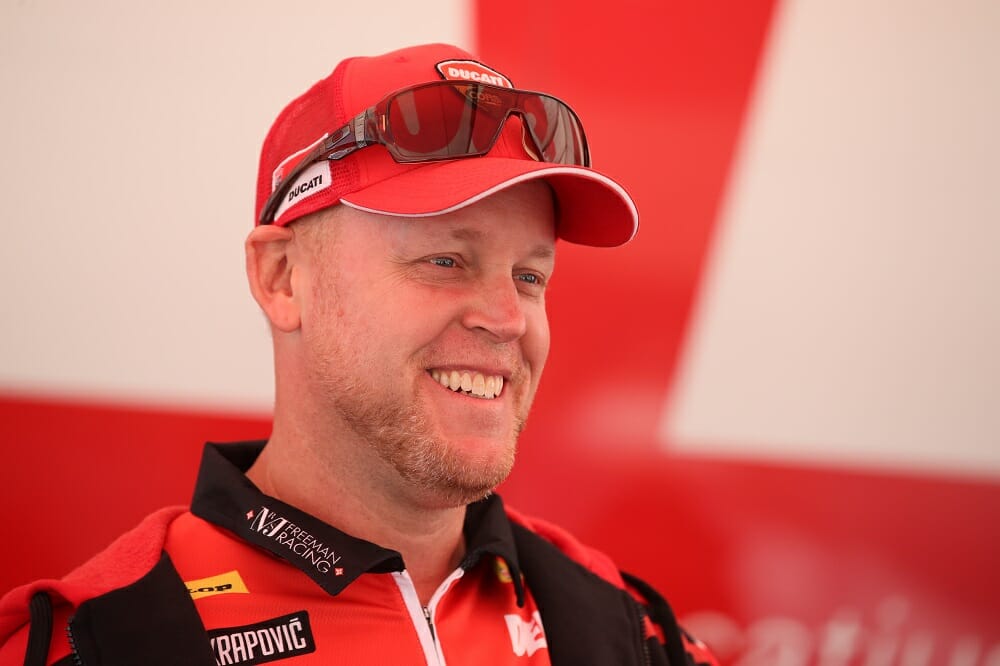
Richie Alexander
Team owner and former AMA Pro Road Racing Champion Richie Alexander has been around racetracks for most of his life yet the passion for his sport is still as strong as ever. The New Yorker is seeing the benefit of benefit of being the lone red team in MotoAmerica, which was a conscious business decision to further cement Hudson Valley Motorcycles as a premium Ducati dealer.
Why did you choose to race Ducatis this year? You could have raced Kawasaki for considerably less as you’re a Kawasaki dealer.
Choosing Ducati was business decision but, since becoming a Ducati dealer four years ago, I just appreciate what the brand stands for and I wanted to be a part of something different. Nothing’s really been done in America [racing] for five, six years now. I thought it was time, since this machine’s been having such success overseas, that somebody does it. John Freeman [the Freeman in Freeman Racing], is actually a customer of mine, who has become a close personal friend. He and his family had an instant connection with Corey, and he fell in love with everything we at our dealership stood for. We bought him into our life because we share a passion for racing—he’s a Ducati guy and loves being involved in the sport but also the brand itself.
How has the venture worked out so far?
Great. Corey does a really good job of marketing, PR and the image with pretty much everything we do. I think this year we did a really good job getting the #RideHVMC name out there. Corey came up with Ride HVMC. It’s a catchy phrase. We carried it onto this year because I wanted to build a brand identity around Hudson Valley Motorcycle. We are not just a race team, we do track days and also custom builds. The whole idea was to build Ride HVMC up as the cool part of Hudson Valley Motorcycle.
You starting to see results because of this branding process?
Yeah, absolutely. We have a huge following. The event we did this weekend with the fire department, we got so much from that. It was done for 9/11. I didn’t really expect the response that we got. Even in Europe we saw some reposts. That’s helping but obviously we did that to support 9/11.
Corey’s done a really good job. He’s a racer but he loves PR. He loves how things look and designs everything himself. So, I may not see today the sales difference today, but the growth of the team turns into sales. I always look down the road two or three years—what am I doing now that’s going to help me in two or three years? That’s what this project is about.
 The team produced a stunning tribute to the 9/11 firefighters (right) for the second New Jersey round.
The team produced a stunning tribute to the 9/11 firefighters (right) for the second New Jersey round.
How has the season been in your eyes?
We got some podiums right off the bat, which was awesome. It was unexpected, but it was here at his home track. Weather played a big part for us. Corey rides very well in the rain and the Ducati’s rain electronics are phenomenal. When we went to the dry tracks, we didn’t have any testing. The second race for us was at Road America and that put us in the first week of June. He really didn’t have more than 10 dry laps going into that race weekend because the race we were at prior, there was really only half a session in the dry. We were behind the ball for racing this street bike—that’s what it is, with a couple bolt-on parts. Still, the electronics in these street bikes is quite advanced. We didn’t really have the capability to get into these electronics as we needed, until just recently. So a good portion of the season, we struggled with that. So if you think about it, the final race of 2016 was our fifth of the year and we had two tests. We’ve ridden the bike seven times this year in total. It’s really not a lot for what was being asked of the bike and the rider.
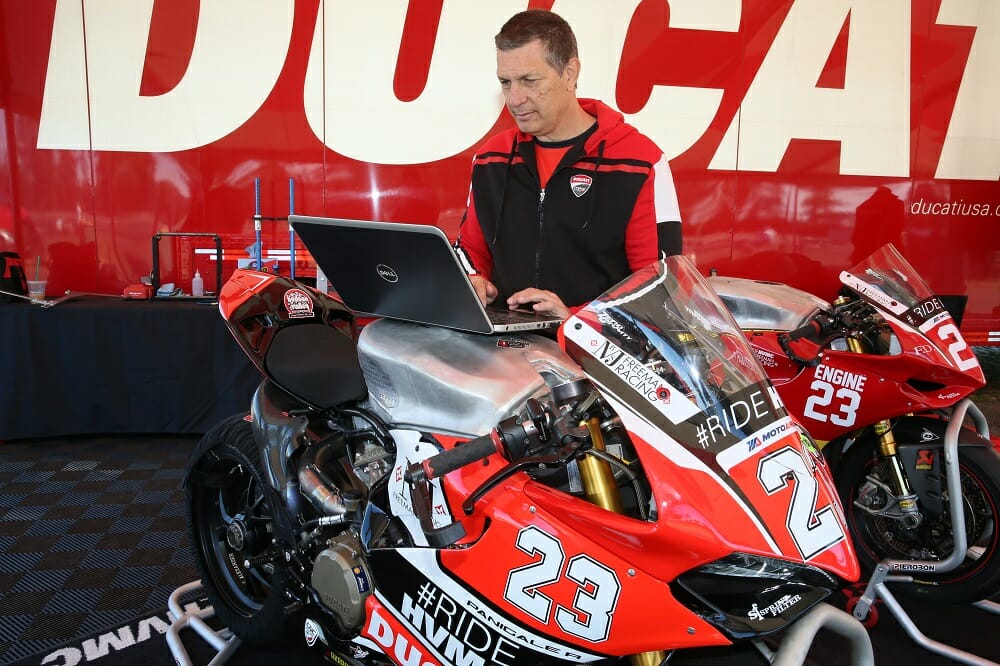 Alexander debuted the Panigale R with a brilliant double podium in the wet at round three.
Alexander debuted the Panigale R with a brilliant double podium in the wet at round three.
Pete Mauhar
Drafted into the team from the round seven at Utah Motorsports Campus, #RideHVMC Crew Chief Pete Mauhar from Gemini Racing has a wealth of experience in the AMA Pro Road Racing paddock, including the managing the Michael Jordan Motorsports team for a decade. Pete’s input was vital in getting the Ducati Panigale’s electrical issues sorted for round eight onwards at Laguna Seca.
What were some of the issues you faced with the development of this Panigale R?
Basically, I flew into Miller and hadn’t really even seen the bike before, only pictures. The team was struggling a bit with the stock electronics, the fuel mapping, some of the general “make the bike run” stuff. The on/off throttle was bad. I think each weekend we’ve tried to make some strides towards improving the electronics package which was traction control, wheelie control and electronic engine braking. It kept getting better each weekend, and with that being more stable we could then focus more on suspension.
You guys were using Tune Boy software from Australia for the first half of the year, and then you had a Ducati Corse technician come over and re-flash the ECU back to stock.
Right, and we’re just manually mapped it here at the racetrack instead on a dyno where it belongs, but because we were in the middle of the season we didn’t have the time to do that. We’ve been looking at lambda curves and picking points out and going in and changing the map.
Are you going to run the Magneti Marelli electronics next year?
I think we are, yes. It’s a new system. It’s a proven system. All of the world superstock teams run it, so that is a better starting point. It’s more tunable whereas here, this is a street bike with street electronics. The parameters what was in for say traction control, those settings work for the street but they really don’t for a racer at race pace. I think the Magneti Marelli will give us two things: it’s a lot more tunable and it also integrates data acquisition where you don’t have a piggyback BBS system to alter the wheelie and traction control settings, like we use now.
What about suspension? How does Corey like his bike set up?
On the 600s he seemed to like a somewhat high front that was soft with lots of trail, with the rear a bit low and stiff and not a lot of movement. But the Ducati is a whole different animal. Here we’ve tried a high bike, a low bike, a front-heavy bike, a back-heavy bike, big preload, little preload. We haven’t really hit the sweet spot yet. Even some of the changes I’ve made to try to get Corey to come in and even say, “Wow, that’s horrible. That’s definitely the wrong direction.” But we haven’t even seen that.
So you’re taking big chunks out of it and not seeing the equivalent result.
Right, which you’d think you would see. So we’ve been struggling with that.
Does that come down to the monocoque design of the Panigale R?
It may. It might be a characteristic of the bike with the short swingarm and no frame. Maybe it’s the tires. It may also be that we’re running different suspension than they do in Europe, or the factory traction control and wheelie stuff that’s still fighting us. We’re not really sure, exactly. We can get the bike to the point where he’s almost at race pace, but he needs that half a second and we’re trying to find the solution that gives him the confidence to push that little bit harder. CN
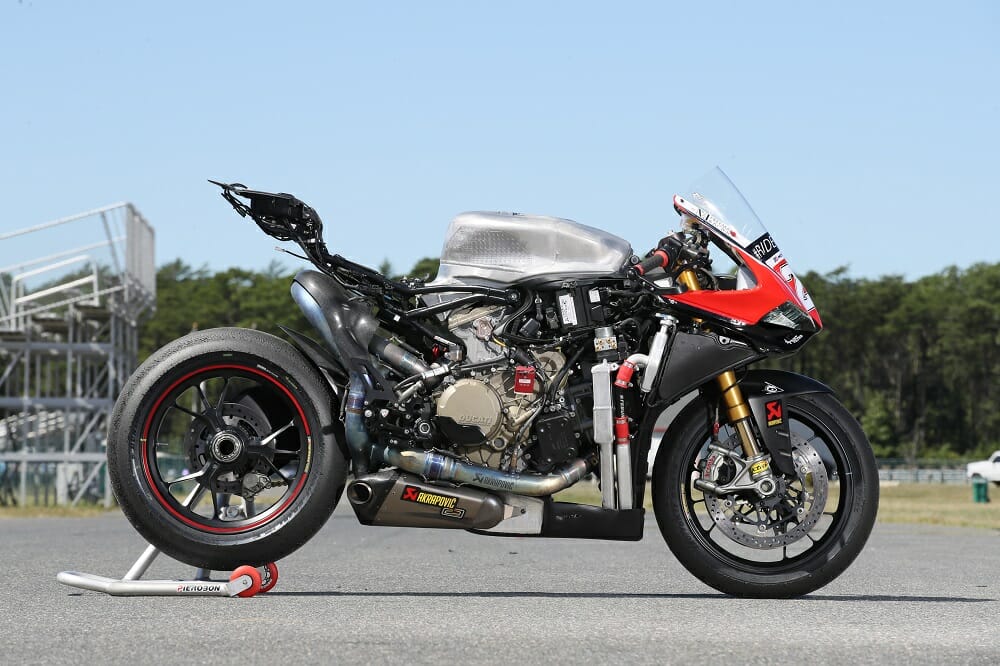
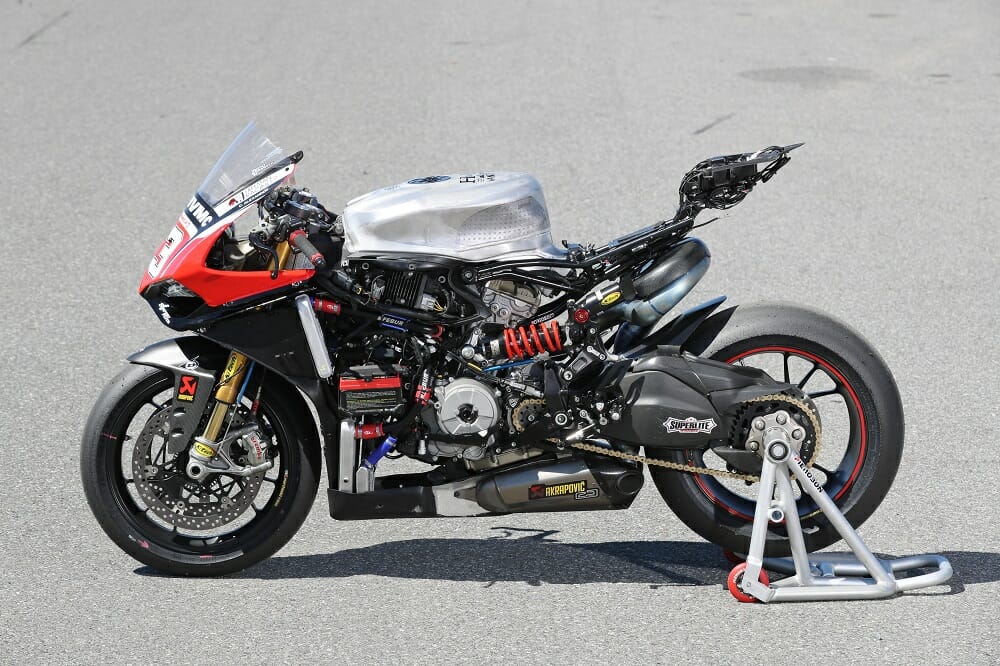
- Standard wheels
- Standard calipers
- Brembo 19 x 20 front brake master-cylinder
- Stock ECU
- BBS Data Processor
- Stock radiator
- Febur second radiator
- Ducati Corse kit clutch with heavier springs than standard
- Ducati Corse quick-action throttle
- K-Tech internal front suspension
- Standard dash
- Fuel tank evaporative can
- Ducati Corsa Brake pressure sensor
- Ducati Corse Akrapovic titanium exhaust
- CNC Racing rearsets
- Pierobon-modified standard gas tank
- Armour bodywork
- K-Tech rear shock
- AIM Evo 4 Data Logger
- Superlite sprockets
- D.I.D chain
- Red Samco cooling hoses
- 6lb weight in center of belly pan
To read this in Cycle News Digital Edition, click HERE
For more Ducati motorcycle reviews, click HERE.
For more Cycle News Sport Bike motorcycle reviews, click HERE.